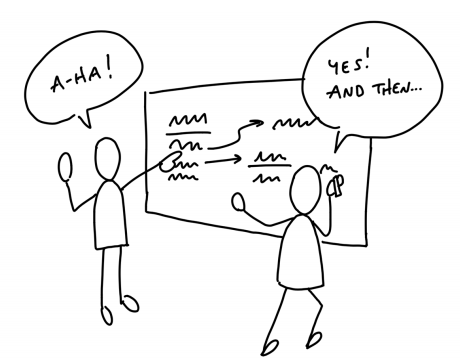
Our Process = How Might We?
Mikey Centrella - 2020-07-15This digital innovation team is new to PBS. But Innovation has been deeply rooted in PBS culture for a long time. However, it is usually tied to specific programs, projects and initiatives. Our charter? Go after the tech, not the problem. We figure out the configuration, not the content. So our purview is really about new technology, new tools not product backlogs, nice to haves, or table stakes.
I like to say we build concept cars, but really we make prototypes. I still think concept cars are a nice metaphor because those cars showcase the possibilities. The car is by no means ready for sale, and in some cases it isn’t even 100% finished.
So we design and develop enough to learn, and not more. We create prototypes that are real enough to test and see if we are on the right track. We try to answer technical and product focused questions in the experiment, but not build out full features.
I’m pretty sure I remember Ira saying something like: “Whatever you think is cool or up and coming, go figure it out.”
That said, we know he has goals that we try to align too, and if a byproduct of our work is also potential new revenue stream or audience solution, then we get to eat our cake too.
So what’s our process? We try not to think of it as agile or waterfall or some sort of hybrid. Our project management is about choosing what works for what is needed. Sometimes we need a week or two to just research and learn before even defining a project idea.
Sounds a bit loose. So at one point we tried to draw some more lines in the sand to help steer the ship. It looked like this:
Vision
To make PBS the most desired, trusted, valued, and supported digital media choice in America.
Mission
Deliver content to the American public that educates, inspires, entertains and empowers individuals from a diversity of perspectives which strengthen the social, democratic and cultural health of the United States.
Objectives
Discoverability
-
Awareness
-
Search
-
Distribution
Engagement
-
User experiences
-
Content experiences
-
Dynamic, live and interactive and cross device video experiences
Conversion
-
Customer journey upgrades
-
Fundraising opportunities
-
Nurturing & retention tactics
Guidelines
- Look to the tech first, then see if it fits a problem
- Experiment and explore trends from other companies outside of category
- Don't let requirements clutter the sandbox
- Research & discovery might need as much weight as design and development in the sprint cycle
- Fail first, fail often
- Stay ahead of the curve, don’t take on projects that are already in the pipeline
- Evaluate needs, ideas, suggestions from across the company and prioritize them based on their potential for generating revenue, audiences, or breakthroughs
- Be data driven and make decisions based on customer needs/wants/unmet/unknown
- Prototype modeling should be iterative and incremental, and adapting
- User testing should be objective and independent from PBS staff
Identifiers
- What do we think core PBS customers want?
- What do we think customers who like PBS content, but don’t give or subscribe want?
- What do we think will make unaware customers interested?
- What makes PBS hard to copy?
- How do we determine if prototypes are successful?
Mantras
- produce project work that creates impact
- changes consumer behavior
- inspires action
Pablo Casals was a brilliant cellist, and I heard about a remark that he reportedly made when he was in his eighties. 80 years old, filled with life long achievements, still performing and practicing all the time. And when he was asked why he was still practicing and not retiring, he made a statement like:
“I think I’m making progress.” … “I think I see some improvement.”
That about sums it up. We’re getting somewhere. I think.
Stay focused and keep learning!
Mikey